Work on this portion of the assignment individually Nobody e
Solution
.model small
.stack 100h
.data
number db 169d ;variable \'number\' stores the random value
;declarations used to add LineBreak to strings
CR equ 13d
LF equ 10d
;String messages used through the application
prompt db CR, LF,\'Please enter a valid number : $\'
lessMsg db CR, LF,\'Value if Less \',\'$\'
moreMsg db CR, LF,\'Value is More \', \'$\'
equalMsg db CR, LF,\'You have made fine Guess!\', \'$\'
overflowMsg db CR, LF,\'Error - Number out of range!\', \'$\'
retry db CR, LF,\'Retry [y/n] ? \' ,\'$\'
guess db 0d ;variable user to store value user entered
errorChk db 0d ;variable user to check if entered value is in range
param label Byte
.code
start:
; --- BEGIN resting all registers and variables to 0h
MOV ax, 0h
MOV bx, 0h
MOV cx, 0h
MOV dx, 0h
MOV BX, OFFSET guess ; get address of \'guess\' variable in BX.
MOV BYTE PTR [BX], 0d ; set \'guess\' to 0 (decimal)
MOV BX, OFFSET errorChk ; get address of \'errorChk\' variable in BX.
MOV BYTE PTR [BX], 0d ; set \'errorChk\' to 0 (decimal)
; --- END resting
MOV ax, @data ; get address of data to AX
MOV ds, ax ; set \'data segment\' to value of AX which is \'address of data\'
MOV dx, offset prompt ; load address of \'prompt\' message to DX
MOV ah, 9h ; Write string to STDOUT (for DOS interrupt)
INT 21h ; DOS INT 21h (DOS interrupt)
MOV cl, 0h ; set CL to 0 (Counter)
MOV dx, 0h ; set DX to 0 (Data register used to store user input)
; -- BEGIN reading user input
while:
CMP cl, 5d ; compare CL with 10d (5 is the maximum number of digits allowed)
JG endwhile ; IF CL > 5 then JUMP to \'endwhile\' label
MOV ah, 1h ; Read character from STDIN into AL (for DOS interrupt)
INT 21h ; DOS INT 21h (DOS interrupt)
CMP al, 0Dh ; compare read value with 0Dh which is ASCII code for ENTER key
JE endwhile ; IF AL = 0Dh, Enter key pressed, JUMP to \'endwhile\'
SUB al, 30h ; Substract 30h from input ASCII value to get actual number. (Because ASCII 30h = number \'0\')
MOV dl, al ; Move input value to DL
PUSH dx ; Push DL into stack, to get it read to read next input
INC cl ; Increment CL (Counter)
JMP while ; JUMP back to label \'while\' if reached
endwhile:
; -- END reading user input
DEC cl ; decrement CL by one to reduce increament made in last iteration
CMP cl, 02h ; compare CL with 02, because only 3 numbers can be accepted as IN RANGE
JG overflow ; IF CL (number of input characters) is greater than 3 JUMP to \'overflow\' label
MOV BX, OFFSET errorChk ; get address of \'errorChk\' variable in BX.
MOV BYTE PTR [BX], cl ; set \'errorChk\' to value of CL
MOV cl, 0h ; set CL to 0, because counter is used in next section again
; -- BEGIN processing user input
; -- Create actual NUMERIC representation of
;-- number read from user as three characters
while2:
CMP cl,errorChk
JG endwhile2
POP dx ; POP DX value stored in stack, (from least-significant-digit to most-significant-digit)
MOV ch, 0h ; clear CH which is used in inner loop as counter
MOV al, 1d ; initially set AL to 1 (decimal)
MOV dh, 10d ; set DH to 10 (decimal)
; -- BEGIN loop to create power of 10 for related possition of digit
; -- IF CL is 2
; -- 1st loop will produce 10^0
; -- 2nd loop will produce 10^1
; -- 3rd loop will produce 10^2
while3:
CMP ch, cl ; compare CH with CL
JGE endwhile3 ; IF CH >= CL, JUMP to \'endwhile3
MUL dh ; AX = AL * DH whis is = to (AL * 10)
INC ch ; increment CH
JMP while3
endwhile3:
; -- END power calculation loop
; now AL contains 10^0, 10^1 or 10^2 depending on the value of CL
MUL dl ; AX = AL * DL, which is actual positional value of number
JO overflow ; If there is an overflow JUMP to \'overflow\'label (for values above 300)
MOV dl, al ; move restlt of multiplication to DL
ADD dl, guess ; add result (actual positional value of number) to value in \'guess\' variable
JC overflow ; If there is an overflow JUMP to \'overflow\'label (for values above 255 to 300)
MOV BX, OFFSET guess ; get address of \'guess\' variable in BX.
MOV BYTE PTR [BX], dl ; set \'errorChk\' to value of DL
INC cl ; increment CL counter
JMP while2 ; JUMP back to label \'while2\'
endwhile2:
; -- END processing user input
MOV ax, @data ; get address of data to AX
MOV ds, ax ; set \'data segment\' to value of AX which is \'address of data\'
MOV dl, number ; load original \'number\' to DL
MOV dh, guess ; load guessed \'number\' to DH
CMP dh, dl ; compare DH and DL (DH - DL)
JC greater ; if DH (GUESS) > DL (NUMBER) cmparision will cause a Carry. Becaus of that if carry has been occured print that \'number is more\'
JE equal ; IF DH (GUESS) = DL (NUMBER) print that guess is correct
JG lower ; IF DH (GUESS) < DL (NUMBER) print that number is less
equal:
MOV dx, offset equalMsg ; load address of \'equalMsg\' message to DX
MOV ah, 9h ; Write string to STDOUT (for DOS interrupt)
INT 21h ; DOS INT 21h (DOS interrupt)
JMP exit ; JUMP to end of the program
greater:
MOV dx, offset moreMsg ; load address of \'moreMsg\' message to DX
MOV ah, 9h ; Write string to STDOUT (for DOS interrupt)
INT 21h ; DOS INT 21h (DOS interrupt)
JMP start ; JUMP to beginning of the program
lower:
MOV dx, offset lessMsg ; load address of \'lessMsg\' message to DX
MOV ah, 9h ; Write string to STDOUT (for DOS interrupt)
INT 21h ; DOS INT 21h (DOS interrupt)
JMP start ; JUMP to beginning of the program
overflow:
MOV dx, offset overflowMsg ; load address of \'overflowMsg\' message to DX
MOV ah, 9h ; Write string to STDOUT (for DOS interrupt)
INT 21h ; DOS INT 21h (DOS interrupt)
JMP start ; JUMP to beginning of the program
exit:
; -- Ask user if he needs to try again if guess was successful
retry_while:
MOV dx, offset retry ; load address of \'prompt\' message to DX
MOV ah, 9h ; Write string to STDOUT (for DOS interrupt)
INT 21h ; DOS INT 21h (DOS interrupt)
MOV ah, 1h ; Read character from STDIN into AL (for DOS interrupt)
INT 21h ; DOS INT 21h (DOS interrupt)
CMP al, 6Eh ; check if input is \'n\'
JE return_to_DOS ; call \'return_to_DOS\' label is input is \'n\'
CMP al, 79h ; check if input is \'y\'
JE restart ; call \'restart\' label is input is \'y\' ..
; \"JE start\" is not used because it is translated as NOP by emu8086
JMP retry_while ; if input is neither \'y\' nor \'n\' re-ask the same question
retry_endwhile:
restart:
JMP start ; JUMP to begining of program
return_to_DOS:
MOV ax, 4c00h ; Return to ms-dos
INT 21h ; DOS INT 21h (DOS interrupt)
end start
RET
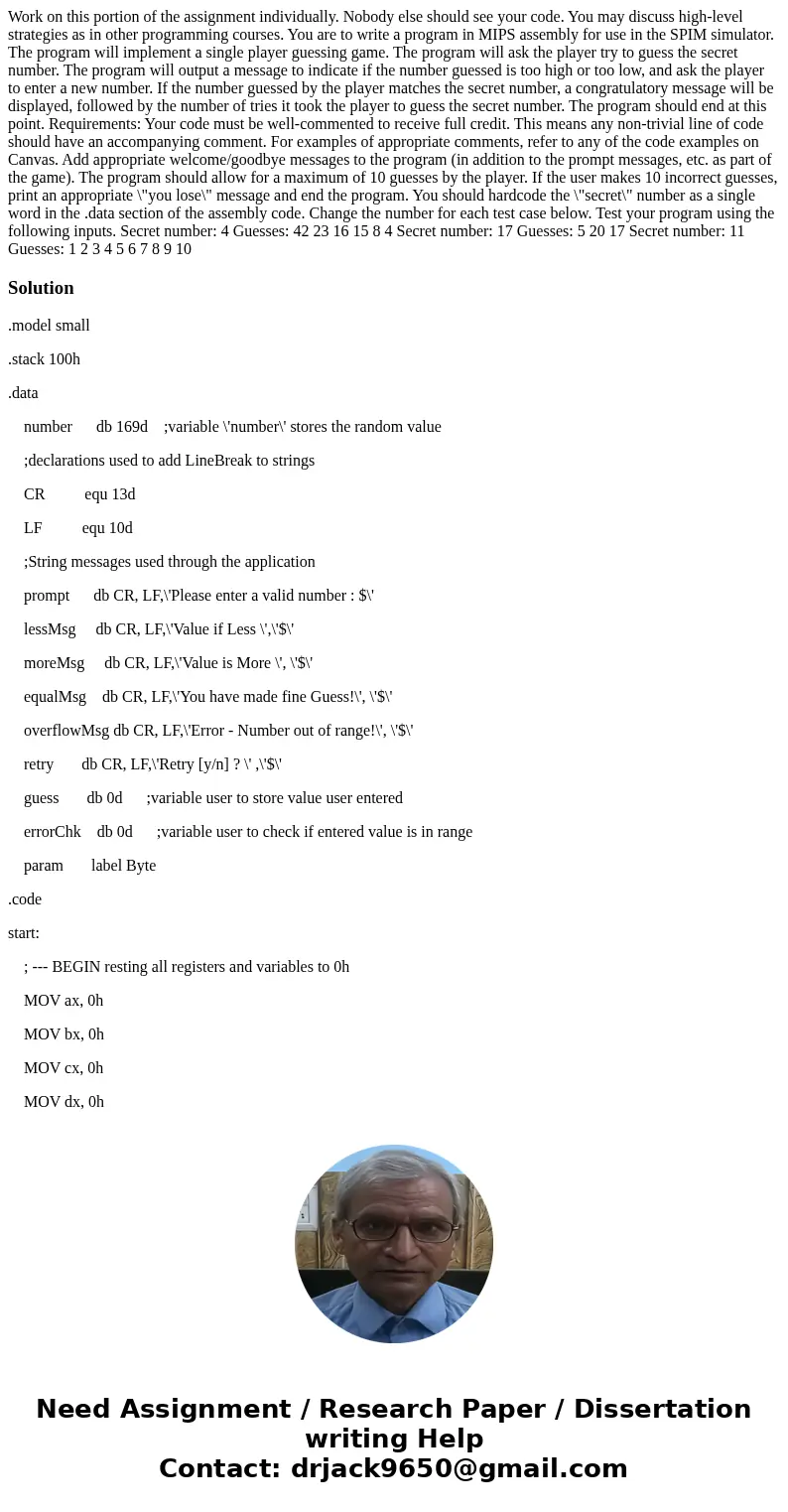
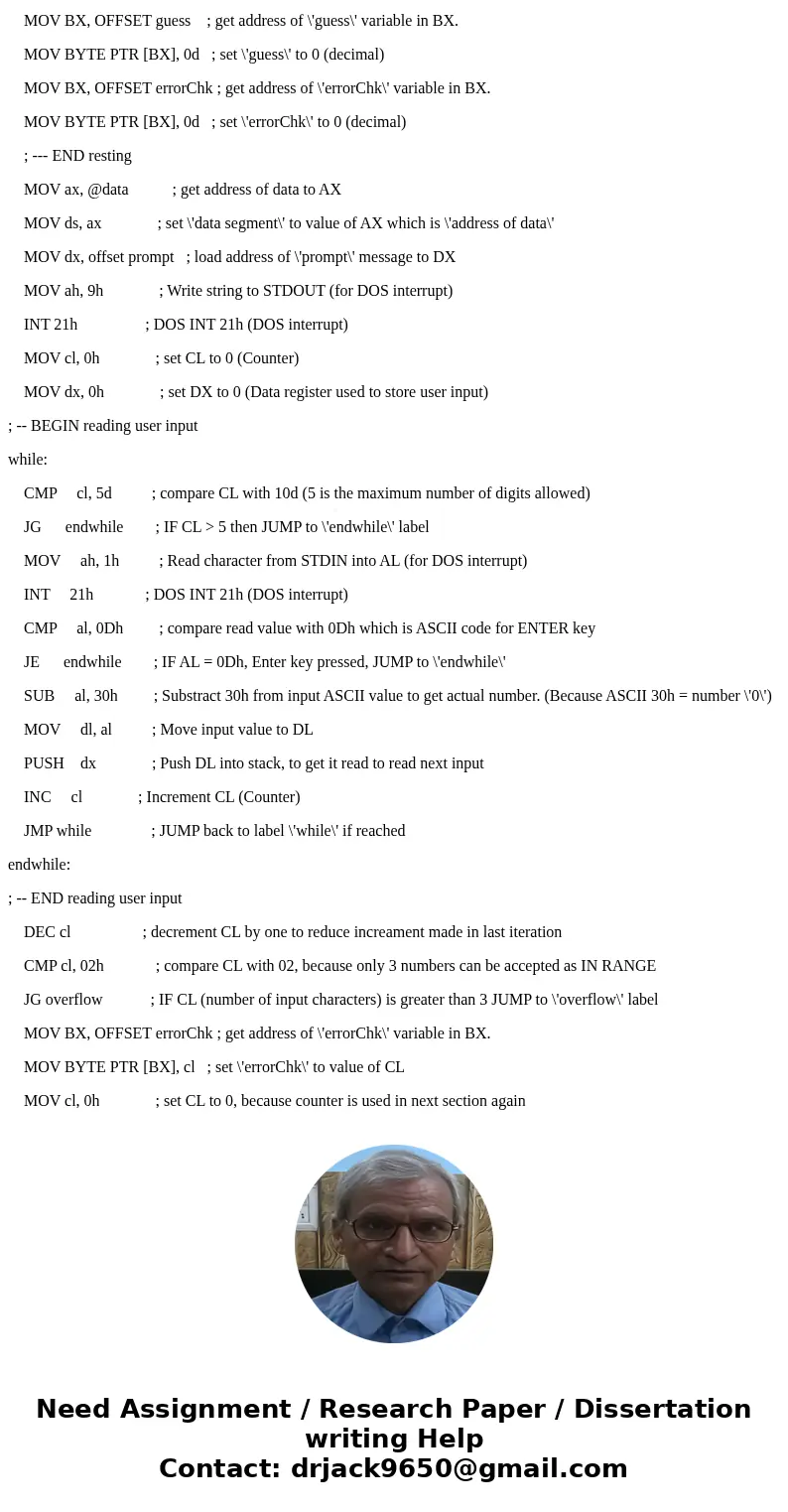
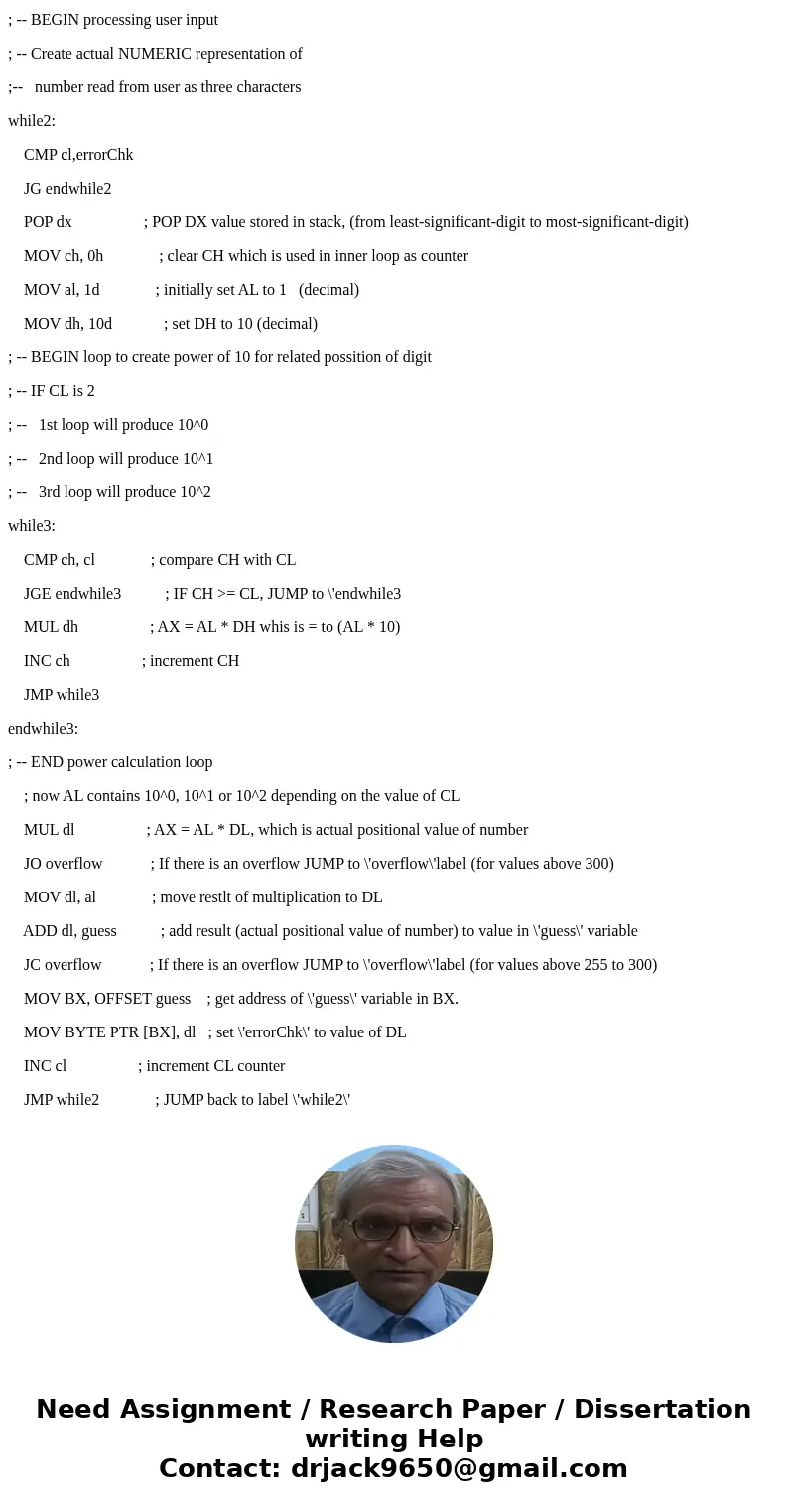
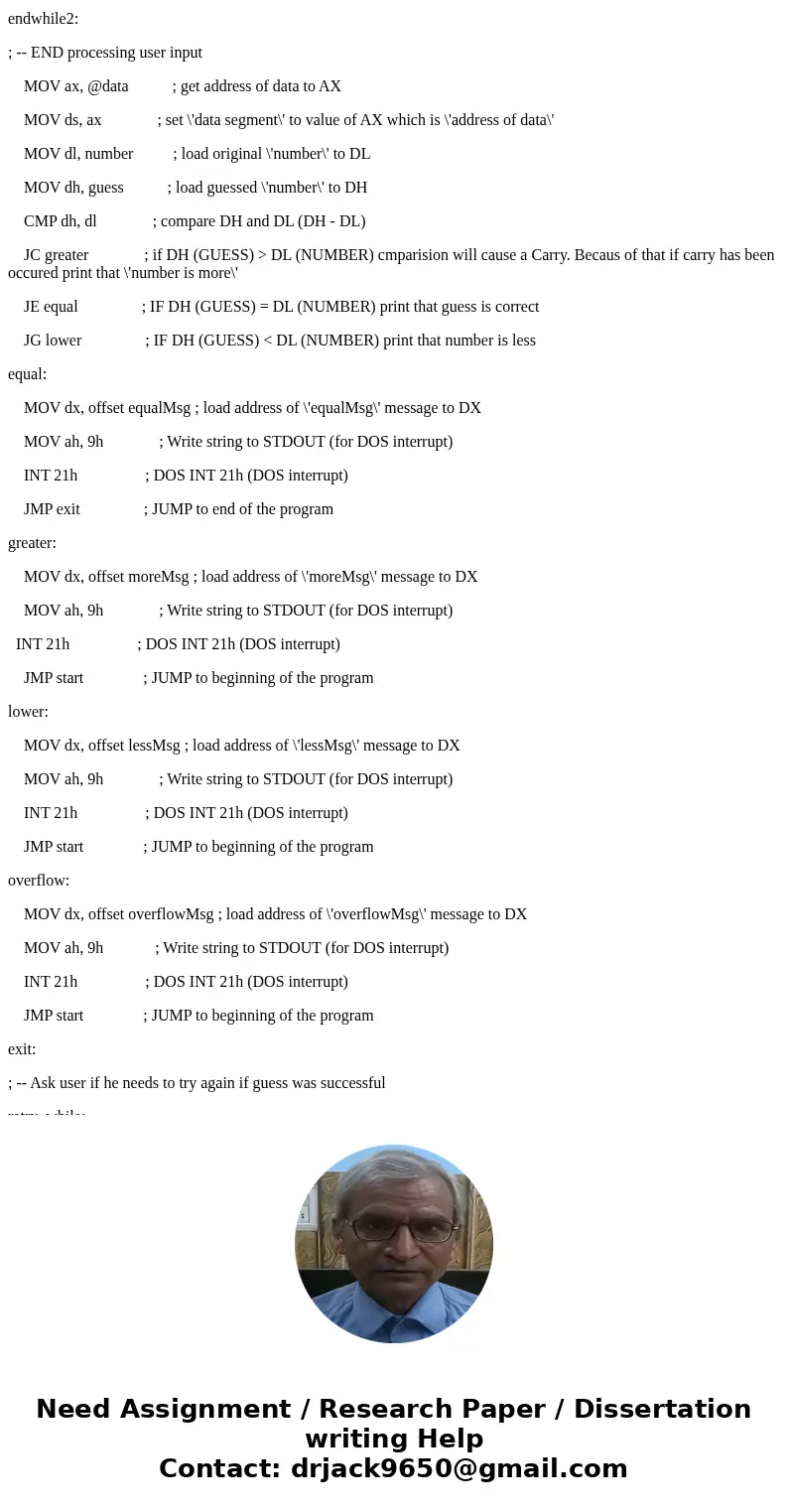
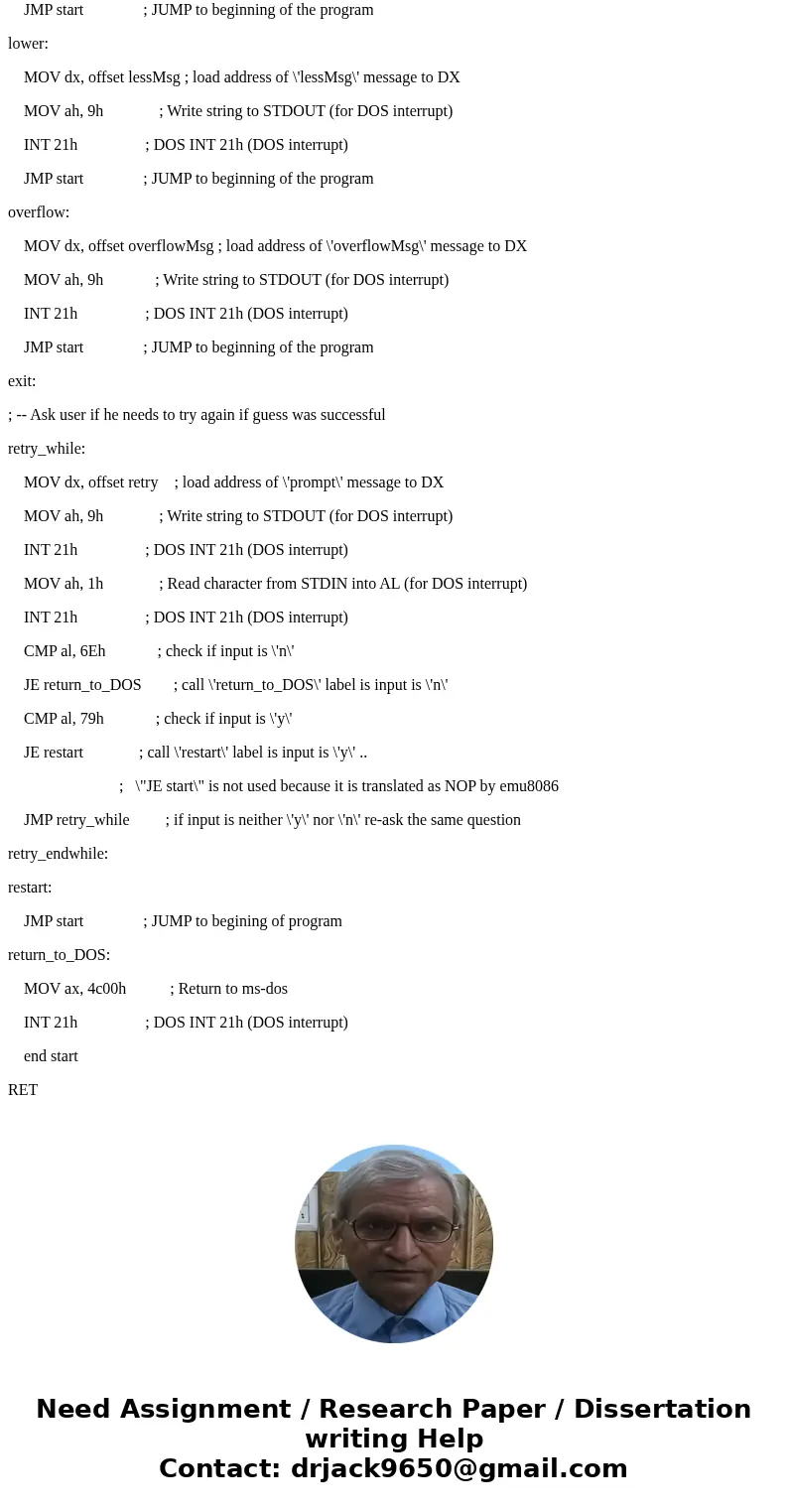
 Homework Sourse
Homework Sourse